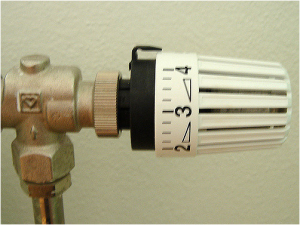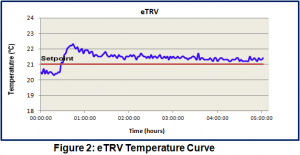Introduction
Interested in saving money and improving staff comfort and productivity? Then it’s important that you choose the right Thermostatic Radiator Valve (TRV) for your needs.
A TRV is a TRV isn’t it? Sadly no.
This blog explains how TRVs work, their differences and advice on what can be used in what application.
What are TRVs?
TRVs control room air temperature by regulating the flow of hot water into radiators. Using the right TRV correctly, offers effective local control appropriate to the varying needs of the occupants. See also here.
The TRV consists of a (temperature) controlling valve head that sits on top of a valve body.

Typically, the valve head contains a (wax, or liquid based) capsule* that contracts or expands with changes in temperature. When the room is too hot, the expanding capsule (via a pin) closes the valve, reducing the hot water flow into the radiator. The converse happens if the room is below the setting. As the room temperature varies above and below optimal levels, the valve works to keep you comfortable.
That’s the theory anyway.
Comparing TRVs and Optimum Usage
The Basic Radiator Valve (RV)
Let’s get the basic radiator hand valve out of the way. This valve works by turning a knob to reduce, or increase the hot water flow, offering only manual control of heating. It is highly inefficient and wastes money and energy. There also needs to be the added cost of Lockshield valves to balance the system so that radiators at the end of the loop are not starved of heat.
Thermostatically Controlled Radiator Valve (TRV)
Until recently these have been the standard solution for radiator control. With their basic temperature regulation, it’s not a precision instrument (normally 1-5 on a dial). As we know ourselves, it’s tough to be comfortable with these.
BTW: Some TRVs have remote sensing heads, with wire tubing to a thermostat (more costly and somewhat unsightly). These are a solution for radiators when the local thermostat is ineffective, e.g. enclosed in cabinet,. These can reduce the ‘radiated effect’ (see later) and offer some improved control.
TRVs are also not as effective reducing costs and energy as you would expect due to:
- Multiple radiators: controlling these in a same room is expensive and problematic
- External influences: sunlight, draughts, other heat sources
- Radiator heat radiation: the radiator itself influences the thermostat (see figure 1 below)
- Personnel interference: uncomfortable staff adjusting temperature settings, open windows to cool and using electric heaters
- Non-occupancy: an unused room has heating at the last setting
- Mechanism seizure: they need regular maintenance (see below)
Use should ideally be limited to small areas, when there is a 7×24 need for consistent temperature.
Programmable TRV (aka Programmable Radiator Control – PRC)
These valves can be programmed for different temperatures at different times. As an example, when there is no planned occupancy, the temperature can be set significantly lower, e.g. for offices on Sundays, or after 7pm.
Unfortunately, they still suffer from the impact of; multiple radiators, external influences, radiator heat radiation, personnel whims and to a certain extent non-occupancy – all still conspiring to keep your heating bills significantly higher that they should be.
Programmable TRVs are probably best used where people want to use them for domestic zoning, e.g. a house for bedrooms and downstairs, etc..
Heating Compensating TRV
Almost all TRVs fail to address the major problem of radiated temperature from the radiator itself. If you stand next to a hot radiator in a cold room, it is obviously more comfortable than on the other side of the room. This is due to radiated heat.
In the same way (especially when the radiator is heating up) the TRV thermostat experiences that high radiated heat and turns off the flow of hot water. Once the radiated heat has a lower impact than ambient heat, the flow starts again. Then again off…… then on……..etc.. As such, the room stays cold for longer than expected.
This results in a saw-tooth temperature behaviour (see figure 1 below) – now we know the reason why sometimes we just cannot get comfortable.
So, temperatures are set higher than necessary at higher cost. Staff are uncomfortably hot (opening windows) and cold (electric heaters) throughout their work day.
Heat Compensating eTRV+ From Chalmor
There is a new generation of TRVs, (eTRV+ from Chalmor) that eliminates temperature fluctuation (see figure 2 below), having:
- A patented DUAL sensor comparing the pipe-work temperature to that of the normal thermostat. Via a complex algorithm, it eliminates the impact of the radiated heat to give occupants a constantly comfortable environment.
- An electronic sensor that gives immediate response to temperature changes – unlike wax or liquid capsule versions.
In addition, eTRV+ further improves staff comfort and saves costs and energy by:
- Being tamperproof, to prevent occupants over-riding the heating.
- A boost feature to set the heating higher for a short period when people are cold.
- Regular valve exercise to prevent seizure due to the accumulation of lime scale and other debris (N.B. over 60%of the UK suffers from hard water).
- Automatically reduce heating when windows are open and temperatures fall.
- Working in conjunction with occupancy sensors.
- Allowing the central thermostat to be used as a ‘high limit.’
- Helping balance your heating system (simple video talks about balancing).
They operate without the need for internet control.
With consistent ambient temperature, occupants are more comfortable at a lower radiator setting. The result is massively lower energy and costs and fast investment payback.
These TRVs are the most effective for any size of organisation.
Web Enabled TRV
Finally, we should not forget the web-enabled TRVs. These have all the advantages of the programmable (and compensating) TRVs, with the added feature that they can be remotely managed.
Now the downside of these are that in many establishments, Wi-Fi is either not available or allowed. Some programmable TRVs rely solely on Wi-Fi to be effective. Apart from WeTRV from Chalmor, they do not offer the same level of heat radiation compensation.
A key consideration for any IoT control, that is so often overlooked, is battery life. Not only is this an added cost, they require time invested in monitoring and replacement.
Contact us at: https://www.chalmor.co.uk/contact/
Email: info@chalmor.co.uk



